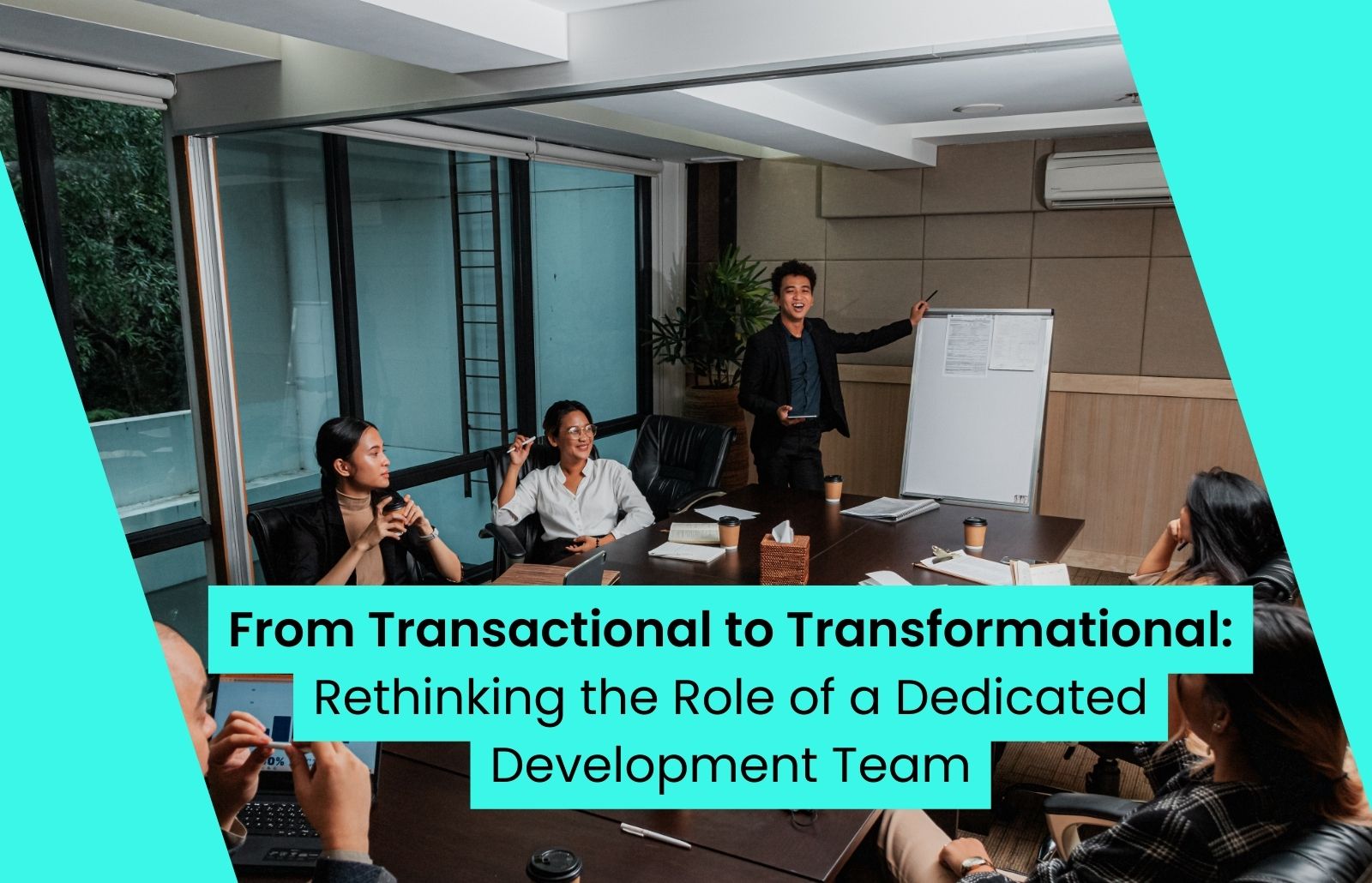For years, the term dedicated development team conjured up a very specific image — one rooted in transactional, offshore outsourcing: a group of developers somewhere far away, writing code for cheap, with little say in the bigger picture.
But that’s not true. At least not for the way we do it.
Today’s best tech companies, from fast-scaling startups to mature enterprises, are moving beyond this narrow view. They’re embracing a new mode: one where the dedicated development team is not a temporary plug-in, but a long-term, strategic extension of their core product and engineering capabilities.
In this article, we’ll explore why this shift is happening, what a transformational dedicated development team really looks like, and how to make it work in practice.
The Origins: The Transactional View of Dedicated Development Teams
The transactional model dominated early perceptions of dedicated development teams. Companies needed extra hands on short notice — and offshore teams offered a quick fix. The appeal was simple: more affordable than hiring in-house, relatively fast to spin up, and often project-based.
But the downsides were just as clear. These teams:
- Lacked long-term product context
- Rarely contributed to architecture or roadmap discussions
- Operated in silos, focused on tickets — not outcomes
As a result, the dedicated development team became synonymous with outsourcing, and all its pitfalls: misaligned priorities, communication breakdowns, and high churn.
That perception still lingers in some boardrooms. But the model itself has evolved.
The Shift: Why Companies Are Rethinking the Dedicated Development Team Model
In today’s tech landscape, hiring great engineers is hard; especially for niche stacks or fast-moving projects. Even companies with strong in-house talent often struggle to scale up at the pace product teams demand.
A modern dedicated development team addresses this gap — not as a stopgap, but as a strategic enabler. Here’s why the model is gaining serious traction:
- Talent shortages in major tech hubs
- Rising expectations around software quality, security, and speed
- The rise of remote work, which makes cross-border collaboration more natural
- More mature delivery partners who bring not just engineers, but structured processes, embedded collaboration models, and domain expertise
Crucially, the most effective dedicated teams today don’t just code. They think, build, challenge, and improve.
What a Transformational Dedicated Development Team Actually Looks Like
Let’s define the shift clearly.
A transformational dedicated development team is not just a squad of developers reporting into a project manager. It’s a deeply embedded, proactive unit aligned with your long-term vision. We are talking about strategic partners here.
Key traits include:
- Embedded culture: The team adopts your tools, rituals, roadmap, and engineering culture.
- Strategic input: They challenge product decisions, contribute to architecture, and identify opportunities.
- Domain alignment: Whether it’s cleantech, fintech, or logistics, they understand the industry and business drivers.
- Scalable structure: The team can expand or reconfigure as needs evolve — without losing cohesion.
This model turns the dedicated development team into a competitive advantage, not a temporary resource.
Imagine launching in a new region: You could hire, onboard, and train from scratch. Or, you could spin up a domain-savvy dedicated team that handles local compliance, integrates with your platform, and gets you live in half the time.
Common Misconceptions That Still Hurt Adoption
Despite this evolution, old myths persist, and often within senior leadership circles unfamiliar with modern delivery models.
Let’s bust a few:
- “It’s just outsourcing.”
→ No. A modern dedicated development team is fully integrated, with shared KPIs and delivery ownership. - “They won’t understand our product.”
→ With the right onboarding and continuity model, they often gain deeper knowledge than in-house hires who switch projects. - “We’ll lose control.”
→ Good partnerships are transparent and agile. You gain flexibility, not chaos.
These misconceptions prevent companies from tapping into a model that could solve both strategic and operational bottlenecks.
The Strategic Advantages of a Dedicated Development Team
Still wondering why so many tech leaders are considering this model?
Let’s get practical. A dedicated development team brings multiple high-leverage benefits:
- Faster scaling: You can add skilled developers in weeks, not months.
- Continuity: Unlike freelancers or short-term contracts, dedicated teams stay — learning, improving, and delivering over time.
- Cost control: You access senior talent without long-term employment costs, recruitment delays, or HR overhead.
- Access to niche expertise: Need AI specialists, platform engineers, or security consultants? A dedicated team can plug into those gaps on demand.
- Focus: Free up your in-house team to focus on roadmap-critical innovation while the dedicated team drives complementary streams.
In short: a modern dedicated development team doesn’t just save money — it unlocks momentum.
What to Look for in a Strategic Partner
Choosing the right partner for your dedicated development team isn’t just about talent — it’s about trust, process, and shared ambition. The wrong choice can lead to delays, missed targets, and cultural misalignment. The right one becomes a long-term growth partner.
Here’s what to look for when vetting a provider — with red flags to avoid and green flags to embrace:
✅ 1. Cultural & Communication Fit
Why it matters: You’re not just outsourcing code — you’re extending your team. That means day-to-day collaboration, shared decision-making, and mutual accountability.
What to look for:
- Fluent, proactive communication (written and verbal)
- Participation in standups, retros, and planning sessions
- Familiarity with agile rituals, async tools, and remote collaboration norms
- Low ego, high ownership mindset
Red flags:
Delayed responses, over-reliance on intermediaries (e.g. account managers), or teams that say “yes” to everything without critical discussion.
✅ 2. Technical Maturity & Breadth
Why it matters: You need more than raw coding ability — you need engineers who understand scalability, architecture, DevOps, and the nuances of your tech stack.
What to look for:
- Senior talent with a track record in relevant domains
- T-shaped engineers who can go deep and wide
- Ability to support with DevOps, QA automation, cloud infrastructure, and security best practices
- Thoughtful input in code reviews and tech decisions
Red flags:
Low-seniority teams, lack of architectural contributions, or providers who only operate via rigid scopes and predefined skill sets.
✅ 3. Strategic Integration Processes
Why it matters: The real productivity of a dedicated development team is unlocked through onboarding, knowledge transfer, and team alignment.
What to look for:
- Clear onboarding roadmap (with documented practices)
- Shadowing and context ramp-up phases
- Internal tooling and documentation protocols
- A delivery manager or technical lead who ensures consistency across people, sprints, and processes
Green flag:
The provider offers a named delivery lead who coordinates with your product owner and ensures KPIs are met.
Red flags:
Teams that “start coding on day one” without understanding the product or team context.
✅ 4. Delivery Visibility & Governance
Why it matters: If you can’t measure it, you can’t manage it. Strategic partners provide transparency — not just activity metrics, but progress, blockers, and risk.
What to look for:
- Shared dashboards or reports on velocity, code quality, backlog, and team health
- Sprint planning and demos aligned to your roadmap
- Proactive flagging of risks, dependencies, or scope creep
- Regular performance and satisfaction reviews
Red flags:
Vague progress updates, missing documentation, or “black box” delivery that only surfaces issues at the last minute.
✅ 5. Flexibility to Scale & Adapt
Why it matters: Your needs will evolve. A great partner grows with you — whether that means expanding the team, shifting roles, or introducing new capabilities.
What to look for:
- Ability to scale up/down with short lead times
- On-demand access to niche skills (e.g. AI, security, analytics)
- Fluid transition support — from MVP to scale, or from one region to another
Green flag:
They’ve supported other clients through multiple phases of growth or pivots.
Red flags:
Rigid contracts, high minimum commitments, or no support for cross-functional collaboration.
✅ 6. Strategic Mindset, Not Just Tactical Execution
Why it matters: You want a partner who’s invested in your outcomes — not just their output.
What to look for:
- Willingness to push back or suggest better solutions
- Engagement in product and tech strategy conversations
- Ownership of impact, not just tasks
- Consistent interest in improving process, performance, and team health
Green flag:
Your dedicated development team feels like part of your own company — contributing ideas, not just completing checklists.
You’re not just hiring developers. You’re selecting a partner who will shape your velocity, product quality, and customer satisfaction. Take the time to assess them across these six dimensions. The difference between a vendor and a strategic dedicated development team is measured in market wins, team morale, and long-term momentum. Your dedicated development team should behave like a partner, not a vendor.
Final Thoughts: The Future of Dedicated Development Teams
The dedicated development team is no longer a band-aid solution.
Done right, it’s a strategic growth lever — unlocking speed, quality, and resilience for modern tech organisations.
It’s not about cutting corners. It’s about expanding capabilities, enriching your culture, and future-proofing your delivery capacity.
So, ask yourself:
- Is your team set up to scale with agility?
- Are you treating external teams as temporary help — or as embedded collaborators?
- And most importantly: Is your current model transformational, or just transactional?
If you’re ready to evolve, maybe it’s time to rethink what a dedicated development team could do for you.
Want to explore how a dedicated development team can accelerate your roadmap? Let’s talk.

